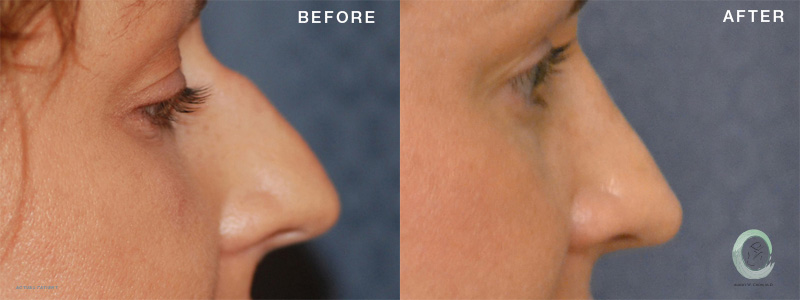This post is in partnership with Dr. Albert Chow.
As mothers, we devote so much of ourselves to our families that it’s almost too easy to ignore a cosmetic or medical issue that’s been bothering us. Are we being selfish if we address it? The short answer: no. There are more valuable ways to expend our mental and physical energy than being uncomfortable or self-conscious, so take the time you need for yourself.
Sometimes, the solution is plastic surgery. Today, we’re focusing on what the procedural options are for your nose. We’ve asked Dr. Albert Chow, a board-certified otolaryngologist and plastic surgeon in San Francisco, to share more about two kinds of nose surgeries, rhinoplasty and septoplasty.
Do I need a rhinoplasty or a septoplasty?
Typically, when people think about nose surgery, the word rhinoplasty comes to mind. This word refers to the surgical procedure that can improve the appearance of the nose—otherwise known as a “nose job.” However, there is also a form of nose surgery that is meant to improve the functionality of the nose. This procedure is called a septoplasty. For people who want a few cosmetic tweaks and breathing improvement, many board-certified plastic surgeons can combine the two procedures.
What is a septoplasty?
A septoplasty specifically improves nasal breathing by correcting a deviated septum. The septum refers to the thin wall between the nostrils that is made of cartilage and bone. When this wall is off-center or crooked, it can cause issues like difficulty breathing, nasal congestion, sinus infections, nosebleeds, sleep problems, headache, and postnasal drip. Sometimes these symptoms can be treated with medication, but more severe cases may require a septoplasty. A deviated septum can be present at birth, may develop during growth, or can be caused by injury to the face.
The correctional procedure can straighten the septum and create more open airways for nasal breathing. A septoplasty requires no change to the outside of your nose. Because it is not considered a cosmetic procedure, it can often be covered at least in part by insurance.
What is a rhinoplasty?
A rhinoplasty can be a good option for healthy adults that are unhappy with the appearance of their noses. However, you must wait until your facial growth is complete to undergo the procedure; this is usually in your late teen years. A rhinoplasty can correct physical issues of the nose, such as an overly wide bridge, a mispositioned tip, or overly large nostrils. It can also eliminate bumps or depressions, as well as shape the nose to better fit the overall face. Rhinoplasties are highly customizable procedures. During the consultation, you can discuss your concerns with your surgeon, who will create a treatment plan that addresses your unique needs.
Rhinoplasties can be performed using a closed or open technique. The closed technique is performed through incisions inside the nostril, so there is no visible scarring. Closed rhinoplasties require excellent skin and are typically reserved for patients who only need minimal work done. Open rhinoplasties involve incisions between the nostrils to separate the skin from the underlying cartilage and tissue. Surgeons use this technique for patients who require more extensive correction.
What are the key differences?
- Purpose: A septoplasty improves functionality, while a rhinoplasty improves appearance.
- Adjustments: A septoplasty changes the septum and inner nasal structures, and a rhinoplasty changes the outer structures.
- Scarring: A septoplasty leaves no noticeable scarring, and a rhinoplasty may leave a small scar depending on the technique used.
Can they be combined?
The two procedures can be combined into a single surgery if you choose a surgeon with the proper training and experience. Though insurance may cover the septoplasty, you will need to pay for the cosmetic portion of the fees. Dr. Albert Chow often performs the two procedures together to help patients achieve multiple goals in one operation. In fact, he sometimes combines nose surgery with other facial plastic surgery procedures, such as chin augmentation, eyelid surgery, or facelift.
Combining your facial procedures will, of course, provide you with more comprehensive results, and it also means that you will only need one recovery period. However, you must do your research and find a qualified surgeon before you start scheduling procedures. Take a look at a surgeon’s real patient before-and-after photos, online reviews, and credentials. These are great ways to get a better idea about a surgeon before actually meeting him or her.






















